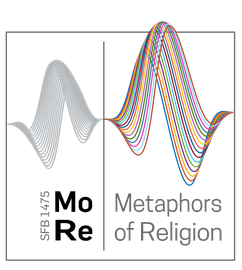Sections of the CRC 1475
The subprojects of the Collaborative Research Center 1475 “Metaphors of Religion” are divided into three sections, which correspond to the three basic source domains. Thus, the subprojects of Section A cover the “Domain of the Physical”, the subprojects of Section B deal with the “Domain of the Mind”, and the subprojects of Section C are dedicated to the “Domain of the Social”.
Section A
In Section A, “The Domain of the Physical,” the focus is on semantics of the physical space and movement as a source domain for the formation of religious metaphors, especially the religious metaphorization of UP and DOWN, FRONT and BACK, LEFT and RIGHT, as well as BEFORE and AFTER. For example, this pertains to religious cosmologies and practices of divination that are oriented towards heavenly bodies (UP), but also a more general UPWARD striving which corresponds with the localization of states of salvation and redemption. Here we are thinking, e.g., of mountains (UP) as special sites of religious practices, or the ideas of heaven (UP) and hell (DOWN), including such spatial variations as are to be found in Dante’s journey through purgatory (UP), hell (DOWN), and heaven (UP). Or the ancient Elysium, which is located in the UNDERWORLD, but is still imagined somehow UP THERE. One central question in this section will be how religion, as a special coordination system, brings together physically determined space (e.g., mountains, sky) and physically determined movement (e.g., ascent and descent) with non-religiously determined meaning and, through this combination, produces specifically religious meaning. We think here of social status attributes such as HIGH STATUS IS UP, political attributes such as POWER IS UP or the moral metaphor MORAL IS UP / IMMORAL IS DOWN. Within the physical domain, we will distinguish between the inanimate and the animate sphere as two sub-domains.
Section B
In Section B, “The Domain of the Mind,” anthropological semantics, especially the religious metaphorization of INSIDE and OUTSIDE, are in focus. This pertains, most notably, to the emergence and development of the inner self as a cultic as well as the religious-moral central entity in need of salvation. Further aspects include phenomena such as ecstasy (“coming out of one-self”), observing oneself from the outside in dreams, or reports about journeys to heaven and near-death experiences—in sum, the notion of the body as the “vessel” of the inner, religious self or as a divine “tool.” Equally relevant are instances of the anthropomorphization of goddesses and gods in terms of their form as well as their inner life of emotions and will. We do not speak of the “myth of outside and inside,” instead, we consider the distinction between mental INSIDE and social OUTSIDE (and, vice versa, between social INSIDE and mental OUTSIDE) as being metaphorically constituted—albeit in semantically different ways.
Section C
Section C, “The Domain of the Social,” examines social semantics as the source domain of religious metaphors, in particular, the religious metaphorization of the IN-BETWEEN as a third entity mediating opposites. These include the religious-metaphorical interpretation of language as a central medium of communication (and in some religions as a medium of revelation), the religious metaphorization of the relationship between humans and goddesses or gods, the religious metaphorization of everyday life, including its inventory as an interpersonal sphere, and the religious metaphorization of law as a sphere for dealing with interpersonal conflicts and the corresponding disorder.

